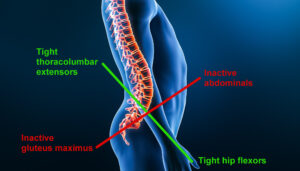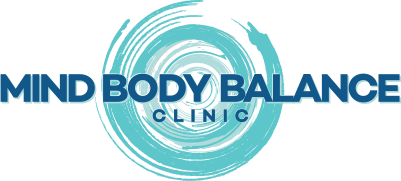
Could Lower Crossed Syndrome Be the Cause of Your Low Back Pain?
Are you constantly battling low back pain, sciatica, hip pain, or plantar fasciitis? If so, you might be unknowingly dealing with Lower Crossed Syndrome (LCS). In this blog post, we’ll explore Lower Crossed Syndrome in-depth and provide actionable insights on how to manage and overcome this condition. Whether you’re an office worker, someone with a sedentary lifestyle, or a chronic pain sufferer, understanding LCS could be the key to alleviating your discomfort and improving your quality of life.
What is Lower Crossed Syndrome?
Lower Crossed Syndrome, also known as pelvic crossed syndrome, is a predictable pattern of alternating muscle tightness and weakness involving the lower back, core, and pelvic muscles. This imbalance often leads to low back pain, degenerative joint disease, and sciatica. The syndrome is characterized by tightness in specific muscles such as the thoracolumbar extensors, hip flexors, and hamstrings, while opposing muscles like the gluteals and abdominals become weak.
How Does It Develop?
LCS typically begins with the overuse of certain muscles, causing them to become shorter and tighter. Opposing muscles, on the other hand, are subject to prolonged stretching, which makes them longer and weaker. This imbalance initiates a cascade of biomechanical changes, including lumbar hyperextension and pelvic unleveling, leading to further dysfunction and pain.
Bio-Mechanical Changes in Lower Crossed Syndrome
The bio-mechanical changes in LCS are significant and far-reaching. Lumbar hyperextension increases spinal force, causing pain and discomfort. Weak gluteal muscles can lead to misalignment in the pelvis, poor balance, and dysfunctional movement patterns. This misalignment can cause internal rotation of the femur and tibia, increased knee stress, lateral knee cap displacement, and foot hyperpronation. These aberrant movements contribute to a host of issues like knee arthritis, plantar fasciitis, and Achilles tendonitis.
Common Diagnoses Associated with Lower Crossed Syndrome
Lower Crossed Syndrome can be linked to various clinical conditions, making it essential to understand its prevalence. Some of the common diagnoses include:
- Lumbar sprain/strain
- Lumbar disc degeneration/herniation
- Sciatica
- Greater trochanteric pain syndrome (hip pain syndrome)
- Iliotibial band syndrome (ITB syndrome)
- Patellofemoral pain syndrome
- Plantar fasciitis
- Lumbosacral facet syndrome
- Knee sprain/strain
- Shin splints
Understanding these conditions can help in identifying whether LCS is the underlying cause of your pain and discomfort.
Therapy Options and Solutions for Lower Crossed Syndrome
The initial treatment for LCS should ideally be conservative, focusing on joint mobilization and myofascial release. Here are some effective therapy options:
Chiropractic Adjustments
Chiropractic adjustments to the thoracic, lumbar, and sacral regions of the spine can help alleviate pain and restore proper alignment.
Soft Tissue Therapies
Soft tissue therapies such as trigger point therapy, dry needling, pin and stretch, and instrument-assisted soft tissue mobilization (IASTM) can be highly effective. These therapies aim to release tight muscles and relieve pain.
Corrective Rehab Exercises
A rehab treatment plan should include stretching hypertonic (tight) muscles and activating inhibited (weak) muscles through corrective exercises. Functional movement programs tailored to your level of function and clinical goals can significantly improve your condition.
Workstation Ergonomics
Improving workstation ergonomics is crucial for those with sedentary lifestyles. Consider using a standing desk or a kneeling chair to reduce the strain on your lower back and improve posture. You can learn more about standing desks and kneeling chairs here.
Nutritional Support
Nutritional supplements can play a significant role in supporting muscle and joint health. Calcium-magnesium complexes can help relax muscles, while joint supplements containing collagen, manganese, vitamin C, MSM, chondroitin sulfate, and glucosamine can support connective tissues.
Postural Exercises and Micro-Breaks
Incorporate postural exercises and micro-breaks into your daily routine. These exercises include specific postural positions and stretches for 1-2 minutes every hour to offset sustained postures and prolonged sitting.
The Role of Weight Management
If you are overweight, following a functional medicine nutrition plan can help you achieve your weight loss goals, thereby reducing the strain on your lower back and improving overall health.
The Importance of Regular Check-Ups
Regular check-ups with a qualified chiropractor or functional medicine provider can help monitor your condition and make necessary adjustments to your treatment plan. Early intervention can prevent the progression of LCS and improve your quality of life.
Take Action Today
Now that you are aware of Lower Crossed Syndrome and its impact on your health, it’s time to take action. Implement the recommended therapies and lifestyle changes to improve your condition. If you need further support, find a qualified, top-rated chiropractor in your area.
Conclusion
Lower Crossed Syndrome is a common but often overlooked condition that can significantly impact your quality of life. By understanding its causes, symptoms, and treatment options, you can take proactive steps to manage and overcome this syndrome. Remember, early intervention and consistent care are key to improving your health and well-being.
For more information and personalized advice, consider booking an appointment with a healthcare professional who specializes in musculoskeletal disorders. Continue exploring our blog for more health tips and stay tuned for next month’s topic on improving your overall wellness.
GENERAL ENQUIRIES
OFFICE HOURS
| Monday | Closed |
| Tuesday | 9am – 6pm |
| Wednesday | Closed |
| Thursday | 9am – 6pm |
| Friday | 9am – 1pm |
| Saturday | 9am – 1pm |
Social Media Outlets
Request Appointment
Please fill out the form below.


